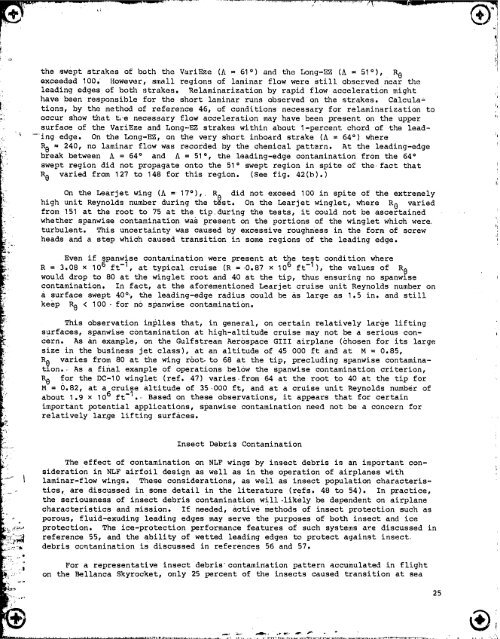NASA Technical Paper 2256 - CAFE Foundation
NASA Technical Paper 2256 - CAFE Foundation
NASA Technical Paper 2256 - CAFE Foundation
Create successful ePaper yourself
Turn your PDF publications into a flip-book with our unique Google optimized e-Paper software.
the swept strakes of both the VariEze (A = 61 °) and the Long-EZ (A = 51°), R e<br />
exceeded I00. However, small regions of laminar flow were still observed near the<br />
leading edges of bo_% strakes. Relaminarization by rapid flow acceleration might<br />
have been responsible for the short laminar runs observed on the strakes. Calcula _<br />
tions, by the method of reference 46, of conditions necessary for relaminarization to<br />
occur show that _e necessary flow acceleration may have been present on the upper<br />
surface of the VariEze and Long-EZ strakes within about l-percent chord of the lead-<br />
-ing edge* On the Long-EZ, on the very short inboard strake (A = 64 ° ) where<br />
R8 _ 240, no laminar flow was recorded by the chemical pattern. At the leading-edge<br />
break between A = 64 ° and A = 51 o , the leading-edge contamination from the 64 °<br />
swept region did not propagate onto the 51 ° swept region in spite of the fact that<br />
R e varied from 127 to 148 for this region. (See fig. 42(b).)<br />
On the Learjet wing (A = 17°), R A did not exceed 100 in spite of the extremely<br />
high unit Reynolds number during the t_st. On the Learjet winglet, where R 0 varied<br />
from 151 at the root to 75 at the tipduring the tests, it could not be ascertained<br />
whether spanwise contamination was present on the portions of the winglet which were<br />
turbulent. This uncertainty was caused by excessive roughness in the form of screw<br />
heads and a step which caused transition in some regions of the leading edge.<br />
Even if spanwise contamination were present at the test condition where<br />
R = 3.08 × 106 ft -I, at typical cruise (R = 0.87 x 106 ft-1), the values of R_<br />
would drop to 80 at the winglet root and 40 at the tip, thus ensuring no spanwlse<br />
contamination. In fact, at the aforementioned Learjet cruise unit Reynolds number on<br />
a surface swept 40 °-, the leading'edge radius could be as large as 1.5 in. and still<br />
keep R 8 < 100-for no spanwise contamination.<br />
This observation implies that, in general, on certain relatively large lifting<br />
surfaces, spanwise contamination at high-altitude cruise may not be a serious con-<br />
cern. As an example, on the Gulfstream Aerospace GIII airplane (chosen for its large<br />
size in the business jet class), at an altitude of 45 000 ft and at M = 0.85,<br />
R@ varies from 80 at the wing r6ot-to 68 at the tip, precluding spanwise contamination..<br />
AS a final example of operations below the spanwise contamination criterion,<br />
R@ for the DC-10 winglet (ref. 47) varies from 64 at the root to 40 at the tip for<br />
M = 6.82, at a cruise altitude of 35.000 ft, and at a cruise unit Reynolds number of<br />
about 1.9 × 106 ft-1. - Based on these observations, it appears that for certain<br />
important potential applications, spanwise contamination need not be a concern for<br />
relatively large lifting surfaces.<br />
Insect Debris Contamination<br />
The effect of contamination on NLF wings by insect debris is an important con-<br />
sideration in NLF airfoil design as well as in the operation of airplanes with<br />
laminar-flow wings. These considerations, as well as insect population characteris-<br />
tics, are discussed In some detail in the literature (refs. 48 to 54). In practice,<br />
the seriousness of insect debris contamination will-likely be dependent on airplane<br />
characteristics and mission. If needed, active methods of insect protection such as<br />
porous, fluid-exuding leading edges may serve the purposes of both insect and ice<br />
protection. The ice-protection performance features of such systems are discussed in<br />
reference 55, and the ability of wetted leading edges to protect against insect<br />
debris contamination is discussed in references 56 and 57.<br />
For a representative insect debris contamination pattern accumulated in flight<br />
on the Bellanca Skyrocket, only 25 percent of the insects caused transition at sea<br />
_, _ _ _ a,_<br />
25<br />
®<br />
J<br />
I

















